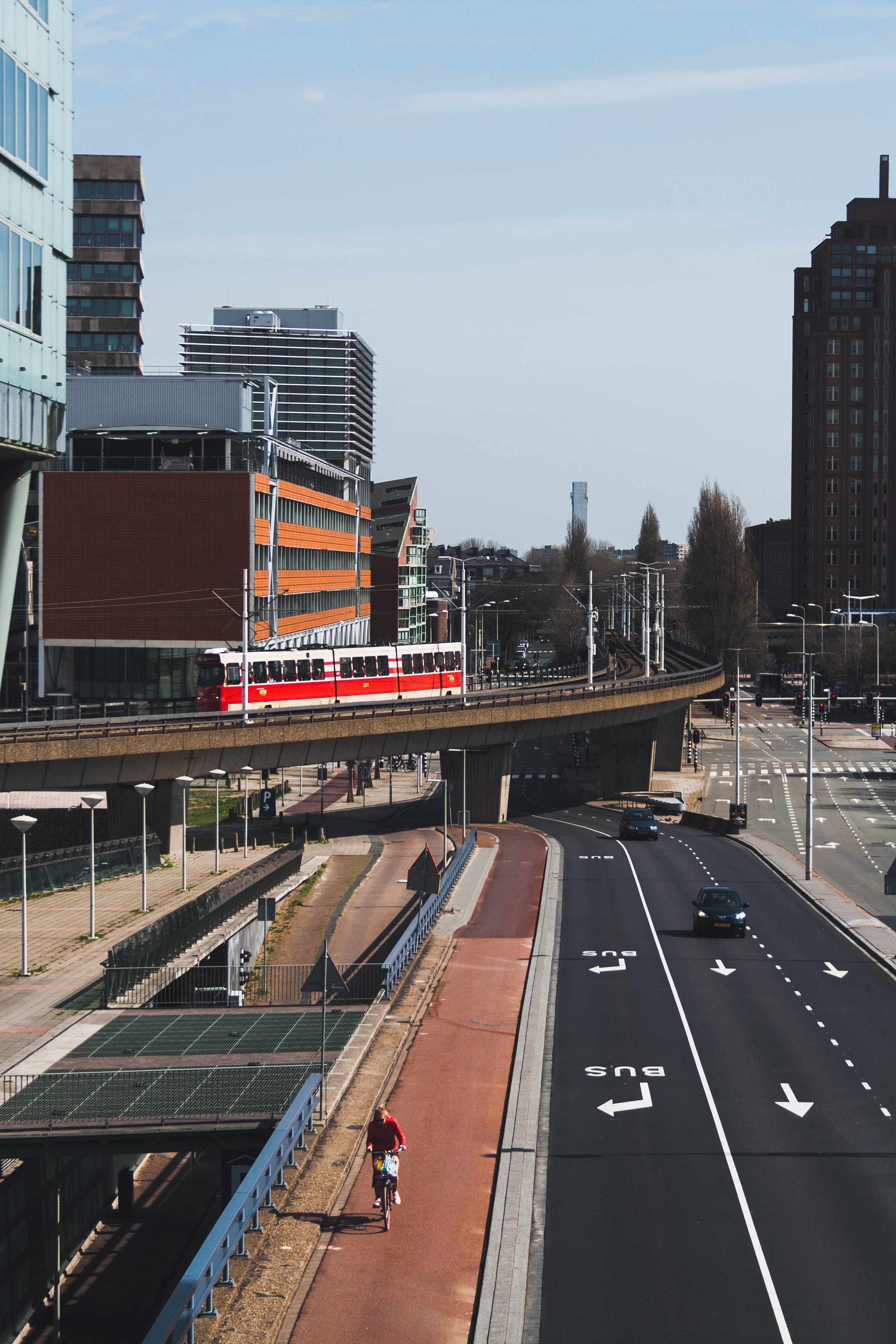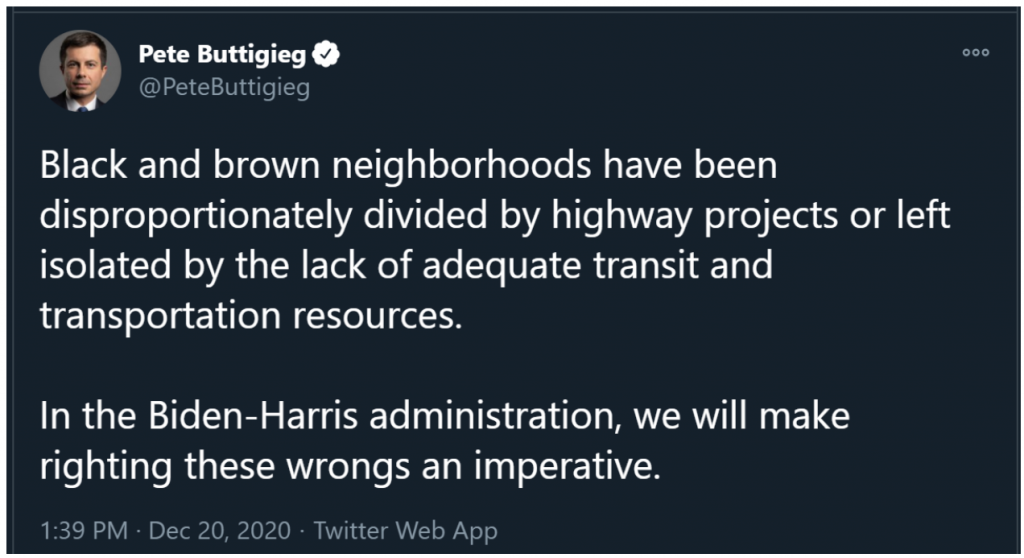How Will Buttigieg Impact Transportation Policy?

- 14th January 2021
[10 minute read]
Former South Bend mayor Pete Buttigieg was nominated to be Secretary of Transportation on December 15, 2020. From recent public statements and prior policy vision expressed during his presidential campaign – there is much we can learn about Buttigieg’s expected policy directions should his confirmation be successful.
As head of the USDOT, and Biden’s leading advocate for infrastructure spending bills on Capitol Hill – Buttigieg’s policy agenda can have a significant impact on future investment priorities for transportation improvement programs (TIP).
We conclude key takeaways for transportation planners at DOTs, MPOs and other transportation agencies on what policy changes may come under Buttigieg.
Four Pillars of Transportation Infrastructure Policy
Since his nomination on December 15, Buttigieg has repeatedly stated four key pillars of transportation policy: jobs, climate change, equity and safety:

- Expand Transportation Infrastructure Spending to Support Job Creation
Buttigieg sees infrastructure spending as an economic enabler for immediate employment relief to millions of people facing distress from the pandemic.
He has recently discussed with Senator Schumer an extensive $1 trillion transportation infrastructure proposal that includes aid for state and local governments, and federal relief to hard-hit aviation and public transit agencies. Just last year, he called for fortification of the underfunded Highway Trust Fund, which provides significant federal funding to transportation improvement programs across every state in the country.
We expect the transportation secretary nominee to be a strong proponent of expanding federal infrastructure spending as an investment in job growth.
- Demonstrate Projects’ Role in Expanding Access to Jobs
In his presidential campaign, Buttigieg advocated for requiring states, MPOs and other federal grant recipients to demonstrate how their transportation projects improve access to jobs and services. The former South Bend mayor previously led a Complete Streets project in downtown South Bend that combined infrastructure changes with economic development by introducing new anchor office tenants who’d bring new jobs to downtown South Bend.
Public transportation improvement projects that can connect communities to new/existing centers of employment clusters may find greater priority or opportunities for federal funding.
Planners may see an additional category of Performance Measures on promoting job access through infrastructure improvement projects if they seek federal funding.
- Green Infrastructure and Social Justice
If Buttigieg’s past comments are indications of what’s to come, social and environmental justice will feature highly as priorities of federally-sponsored projects under his leadership:


Buttigieg has been critical of transportation infrastructure examples that disproportionately disempowered minority communities. He championed greater investments in alternative transportation modal options such as public transit, bike and pedestrian paths to promote more equitable access to transportation and job opportunities, as well as tools for reducing carbon emissions. During his presidential campaign, Buttigieg proposed significantly increasing funding for the Federal Transit Administration to fund public transit projects.
He also proposed switching to vehicle miles traveled (VMT) tax vs. the current gas use tax as a means to fund the perennially troubled Highway Trust Fund account. Experts believe a VMT tax would be successful in disincentivizing driving if properly priced, and steer transportation choices towards greener options such as public transit vs. driving.
In addition to the greater importance of meeting Title VI requirements, transportation improvement plans with projects seeking federal funding may be expected to demonstrate greater social justice commitments, greater public engagement with potentially impacted communities, and greater reductions in carbon emissions.
- Prioritize Maintenance Over New Roads
The former South Bend mayor publicly endorsed prioritizing infrastructure maintenance in transportation improvement program funding. In his presidential campaign, Buttigieg outlined a proposed requirement for states to demonstrate planning on preventative maintenance projects – before they’re allowed to build new or wider highways with federal funding.
Expect greater federal emphasis and scrutiny on adequate planning for preventative maintenance projects in transportation improvement plans seeking federal funding.
- Safety and Vision Zero
Buttigieg has repeatedly stated a need to eliminate traffic deaths and pedestrian fatalities in the country. During the pandemic, rates of car crashes have unfortunately increased due to higher driving speeds on emptier roads.
Buttigieg proposed a policy goal of Vision Zero during his presidential campaign – setting a goal of zero traffic fatalities. Currently, states are able to set fatality goals at a target that demonstrates progress – but not necessarily at zero.
Through his ability to control allocations of discretionary grant funding as head of USDOT – Buttigieg may seek to implement more strict requirements on demonstrating progress on safety records or safer project designs in order to receive federal funding for certain federal programs.
Safety is one of the federal Performance Measures that transportation planners are required to incorporate in transportation improvement plans. It is possible for FHWA to accelerate the timeline states have to achieve zero traffic deaths under Buttigieg. It is also possible that additional discretionary federal funding will be made available to specifically support projects prioritizing aggressive safety targets.
Looking Ahead
While Buttigieg’s policy agenda will be shaped by viewpoints from the Biden-Harris administration – it is clear from his nomination illustrates that he shares similar beliefs with Biden in the role and direction of federal policy in advancing our critical infrastructure.
Transportation planners would benefit from taking early notes on potential changes to future federal policies when evaluating how best to maximize federal funding for transportation improvement programs.

